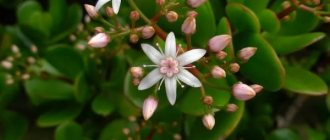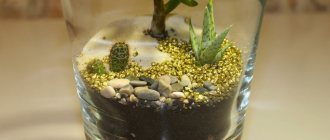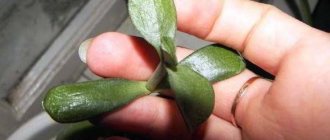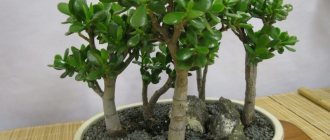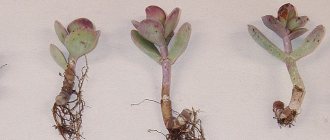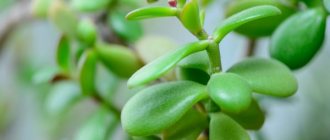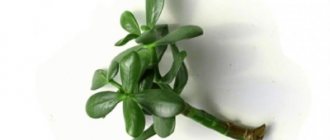The Crassula succulent plant, also called Crassula, is part of the Crassula family. According to information taken from various sources, this genus includes from 300 to 500 different species. More than 200 species are found in South Africa, and many more species can be found in Madagascar and tropical Africa. Some species can be found in the southern part of the Arabian Peninsula; this plant is widespread mainly in the Southern Hemisphere. Its name is derived from the word “crassus”, which translates as “thick”, this is due to the fact that in most species the foliage has a fleshy structure. At home, the most commonly grown species is Crassula purslane; it is also called the “tree of happiness” or “money tree”. However, many other types of Crassula are also grown indoors.
Brief description of cultivation
- Bloom . Crassula is grown as an ornamental foliage plant.
- Illumination . It grows well in bright sunshine, as well as in bright but diffused light, as well as in shade. Windows with east, south and southwest orientation are suitable for this.
- Temperature regime . In summer - normal room temperature, and in winter - from 10 to 15 degrees.
- Watering . Immediately after the surface of the soil mixture in the pot dries to a depth of 20 to 30 mm.
- Air humidity . Any one is suitable.
- Fertilizer . During intensive growth, fertilizing is carried out once every 4 weeks, using a fertilizer solution for succulents and cacti. In the autumn-winter period, the plant is not fed.
- Rest period . It is not pronounced. However, it will be better if such a succulent rests in winter.
- Transplant . About once every couple of years. Transplantation is carried out in spring at the beginning of intensive growth of the bush.
- Reproduction . Seed (generative) method and cuttings.
- Harmful insects . Mealy and rootbugs, scale insects, spider mites.
- Diseases . Gray rot, root rot, trunk rot, late blight.
- Properties . This succulent is capable of releasing substances into the air that have antiviral, antifungal and antibacterial effects. In alternative medicine, its juice is used externally in the same cases as aloe juice, and they are also equally effective in terms of effectiveness. But it should be noted that this juice should not be taken orally, since it contains arsenic.
Crassula (crassula). Planting and care.
Houseplant care
Even a beginner can grow a healthy plant with proper care, but you need to know some of the features of Crassula and strictly follow
Illumination
The plant is not picky about light conditions and can grow successfully in a shaded room. The bright light of the sun does not pose a danger to the fat plant, but direct and prolonged exposure of the rays to the leaves of the plant should be avoided. Give preference to diffused light.
Remember that the lighting of a plant determines its growth, leaf color, and healthy appearance.
Make sure there is enough light in the room, this will help Crassula stay healthy without losing its decorative shape. Use artificial lighting if necessary.
Temperature
In the warm season, it is worth observing the usual room regime, avoiding overheating of the plants, using room ventilation. You can safely send the plant to the balcony in an open room in the summer. In winter, the temperature should not be below 10 degrees.
How to water correctly?
Crassula does not like excess moisture, high humidity , this leads to rotting of the root system, shedding of leaves, disease and death of the plant.
Be sure to use pots with drainage holes, make your own if necessary. Crassula can go without watering for a month; if the plant is not young, then you can safely go on vacation and not worry about anything.
In summer, it is recommended to water a young plant more often, once every 7 days, and adults - once every 14-20 days. Check the soil moisture not from above, but 3-5 cm deeper; if the soil is dry, then you should water the plant.
The money tree should not be sprayed; its leaves themselves are able to accumulate moisture, but if they are watered too much, they can begin to rot and fall off.
Top dressing
Additional fertilizers can be introduced from May to August 20th, this is the period of most active growth. Products suitable for cacti and succulents are used.
During the winter season, the use of fertilizers is contraindicated. They cannot be used after transplanting the plant into a new pot.
Formation of the Crassula
To give the plant the desired appearance, you should follow the following rules:
- if the money tree has reached the desired size, then you should not replant it in larger pots (replace the top layer of soil);
- the crown of the Crassula forms independently in the presence of a sufficient amount of light;
- cutting off excess branches and forming the desired shape should be done when the plant is still very young;
- remove excess shoots, because the Crassula trunk should be smooth and empty (10-15 cm without shoots);
- for a neat shape, each branch should have about 6-8 leaves, the rest can be removed.
Beginners should not get too carried away with cutting leaves; it is better to turn to specialists. You can buy an already mature, formed plant in a specialized store; this will relieve the owner of a number of worries.
Flower transplant
The time for transplantation is chosen in autumn or spring.
Adult plants are replanted more often than once every three years, and young plants - once a year. The transplant is performed in several stages:
- prepare a new pot, necessary equipment and soil;
- carefully remove the plant, place it sideways on a sheet of newspaper;
- remove damaged roots, treat cut areas, leave the plant in this state for a short time;
- Fill the pot for replanting with drainage, soil, compact the contents;
- Now you can carry out the transplantation procedure, place the plant in the center of the container, cover the roots with soil;
- compact the substrate a little;
- Now it’s time to water the plant.
Next, create optimal conditions so that the Crassula feels comfortable. After all, the transplantation process is always stressful for the plant.
You should not replant the plant immediately after purchase; give it time to get used to the new conditions.
From the video you will learn about planting and further care of crassula:
Properties of the money tree
The plant is able to purify the air in the house, ridding it of some viruses and microbes. Crassula has long been used in folk medicine as:
- natural antiseptic;
- painkiller;
- antimicrobial agent.
Most often, the juice of the plant is used externally for skin lesions and rashes. This remedy is effective against:
- herpes;
- calluses;
- nail fungus;
- warts
Remember that Crassula leaves and juice contain arsenic! Use the plant for medicinal purposes with extreme caution; consultation with a specialist is recommended!
There are recipes that involve using the plant internally. So, when treating diseases of the gastrointestinal tract, eat a couple of leaves in the morning before meals.
Features of Crassula
In culture, as in natural conditions, you can find Crassula represented by herbaceous and aquatic plants, tree-like shrubs, there are both very small and large succulents, but they have one common feature: on the shoot their leaf plates are placed crosswise opposite each other . Such a succulent plant, when grown indoors, has a smaller size compared to those specimens that grow in nature; the fact is that such a crassula is limited by the volume of soil mixture, space and other conditions that are necessary for active growth. However, over time, such a flower still becomes a tree with a thick stem. The leaf blades are entire and simple; in some species they are ciliated. The lateral or terminal inflorescences can be racemose or umbellate-paniculate; they include flowers of yellow, red, white or pale blue color. But it should be taken into account that in indoor conditions, the fat plant almost never blooms. This crop is very popular among gardeners due to the fact that it is unpretentious, hardy and very easy to care for.
House Rules
For the harmonious development of Crassula, bright light is needed. She is so ready for this that she has protective mechanisms in case of excess. In mid-latitude conditions, the flower is placed in direct sunlight and ventilated; in the spring, it is taken out to the balcony or garden and sheltered from the rain.
Thick, fleshy leaves contain a supply of moisture, so in summer the ground is watered when the surface layer dries out two to three times a week, in cold weather when the leaves lose their elasticity. Winter maintenance in the house is a test for a flower; during this period it suffers from a lack of light.
It is necessary to create conditions under which the succulent would not grow and retain its decorative properties. For this purpose, a drought is imposed from November to March, and watered when visible wilting occurs. The habitat at this time is a window sill with a temperature of 6–15° C; sub-zero values are dangerous.
Growing in offices or apartments under artificial lighting is not effective; the intensity of the rays is so low compared to the required one that the plants stretch out, lose their attractive appearance and die. The only acceptable option is to store it near a cool window without watering until spring.
Crassula is replanted when the pot is completely filled with roots. To stimulate flowering, this operation is repeated at least once every two years. Select a larger pot, add drainage up to 10–15 cm. Transfer the succulent to a new container and fill the voids along the walls with fresh soil. Long roots are first shortened. To maintain compactness, they do not replant, but replace the top layer annually.
Formation of a money tree
Pinching of the tree-like Crassula begins during growth, so that stumps do not form when pruning thick shoots. The shape of the top depends on the pot. In a large container, the roots grow intensively, the trunks stretch, become thin and weak. To avoid this, choose a low pot with a diameter equal to the size of the crown.
Upon reaching a height of 12–15 cm, the top two leaves are removed, and four will appear instead. This is done with newly formed primordia for branching and crown density. At the same time, cut off the tops of long or irregularly growing shoots to obtain a spherical or oval configuration.
According to the plan, one trunk is left or a plant with several shoots is formed. When creating a bonsai-style tree, gardeners bend it, tie it up, and give it the desired direction. The branches that have stretched out over the winter are shortened to a given size in the spring.
How to care for purchased plants?
Many of the store flowers are of Dutch origin. They are grown in greenhouses, where peat is used instead of soil. These plants are treated with growth stimulants and an exorbitant amount of substances and fertilizers are added to suppress pathogenic microflora.
When moving a purchased succulent to a store, then to the buyer, the conditions of maintenance change. It is difficult to wet peat thoroughly, and after drying, the water passes through the middle of the lump and flows along the walls of the pot. A waterlogged substrate provokes rotting of the root system. Intensively feeding the Crassula in indoor conditions is dangerous, it threatens death, and without feeding in poor soil, it starves. Nitrogen fertilizers are not used, this worsens the appearance of the bush.
The plant purchased in winter is not disturbed, but in the spring it is certainly replanted. Peat is completely removed, rotten and dead roots are cut out. Succulents purchased during the growing season are transplanted immediately or cuttings are taken from them for propagation. If there is no growth, the mother plant is thrown out.
Protection from pests and diseases
The dense covering of the leaves protects them from many parasites. The danger comes from mealy root and stem bugs and thrips, which are common to most Dutch succulent mixes. To combat them with insecticides (Fundazol, Maxim, Oxyx), Crassula is sprayed and the soil is shed. The use of systemic drugs gives a positive result - they make plant sap poisonous. The tick attack is counteracted by treatment with acaricides such as Fitoverm, Actellik, Neoron. In addition to pests, Akarin and Agravertin also destroy eggs.
Fitosporin is used as a preventative measure; as the process develops, it will no longer give the desired result.
Diseases affecting the roots pose a serious danger. Fungal rots develop gradually in cool conditions, bacterial rots develop rapidly in warm conditions, and the plant dies within a few days. If mold or watery stains appear, remove damaged parts immediately. If the base of the trunk is damaged, the upper part is cut off and rooted.
The main cause of succulent malaise is excessively wet soil. It needs to be dried to prevent bacteria and fungi from developing. To prevent rot damage:
- limit watering in the off-season;
- add crushed charcoal to the earthen mixture;
- use pots with a hole for water drainage;
- arrange drainage in them, add expanded clay;
- vegetative propagation is carried out in the warm season;
- dry the cuttings, avoid getting parasites on them;
- Crassula is grown in a well-lit, ventilated place.
Caring for Crassula at home
It is very simple to grow a fat plant indoors; to do this, you need to water it not very often, regularly wash the leaf blades and feed it in a timely manner.
Illumination
Most types of Crassula cannot be harmed by direct rays of the sun, so the container with the flower can be placed on a south-facing windowsill. However, such a crop will grow best on an eastern or southwestern window. If the bush feels a lack of light, this will have an extremely negative impact on its decorative effect, namely: the foliage will fly off and the shoots will become elongated. In the summer, it is recommended to move the fat woman outside, where it will feel great.
Temperature
The fat woman is thermophilic, so this summer she feels good on hot days. And in winter, it can grow quite normally next to heating devices. However, in winter, such a crop feels quite comfortable even in cool conditions (from 10 to 15 degrees). The air humidity in the room can be high or low, the bush will grow equally well.
How to water correctly
In summer, watering Crassula should be done immediately after the top layer of the soil mixture has dried. In winter, you need to wait until the substrate dries to a depth of 20 to 30 mm. Such a plant is not as afraid of the drying out of the substrate as it is of stagnation of water in it. In this regard, it can easily stand for 20–30 days while you are away or on summer vacation.
Top dressing
Feed the bush in spring and summer once every 4 weeks; for this, use a fertilizer solution for cacti or succulent plants. In the autumn-winter period, all feeding is stopped.
Formation of the Crassula
You need to start forming a tree when the bush is still relatively young. The fact is that if you form an already mature plant, then in those places where the stems were truncated or the leaf plates were cut off, stumps will remain, which will have an extremely negative impact on the decorative appearance of the bush.
First you need to choose the right container for planting. If the pot is too large, then the root of the bush will tend to go deeper, and it will begin to actively grow upward, which is why the trunk will become elongated, thin and weakened. In this regard, it is recommended to use a fairly small and low pot for planting. It is important to prepare the correct soil mixture, which should consist of leaf, humus and turf soil, as well as brick chips (fine gravel) and sand (1: 1: 3: 1: 1). After the height of the bush is 15 centimeters, you need to pinch off the 2 smallest leaf plates located at the very top, in this place it will begin to branch, namely, instead of one pair of leaves, two will grow. In a growing bush, you need to systematically tear off the top leaves in those places where you want the stems to branch. This way you will be able to give the growing tree the desired shape.
Crassula transplant
Replanting should be done as needed after the root system becomes very crowded in the pot. It is not necessary to replant the fat plant every year, but in order for it to bloom, it must be replanted once every couple of years. This procedure is recommended to be carried out in spring at the beginning of intensive growth.
The new pot should be only slightly larger than the old one; a fairly thick layer of drainage should be made at its bottom; for this you can use crushed shards or expanded clay. Then the flower is transplanted into a new container by transferring it, while it is taken together with a lump of earth, then all the voids are filled with fresh soil mixture. If the root system of the bush has grown greatly in length, then it must be shortened when replanting so that it can fit in the new container. If you want the bush to be compact in size, you should try not to replant it at all, and once a year you need to change the top layer of the soil mixture.
Money Tree. Crassula. How to replant.
Properties of Crassula
The fat woman is able to preserve the health of everyone who lives in the house where it grows. This flower is capable of releasing substances into the air that have a powerful antiviral, antibacterial and antifungal effect. In addition, the juice of the leaves is widely used in alternative medicine for lotions in the treatment of wasp and bee stings, bruises, herpes, abscesses and cuts. It is also used for rinsing in the treatment of gum inflammation and sore throat. Also, for arthritis, the juice is used for rubbing at night. But keep in mind that this juice cannot be taken orally, since it contains arsenic in high concentrations. It has long been believed that the fat woman brings prosperity to the home and good luck in business. And thanks to its ease of maintenance, it is often found not only in apartments, but also in shopping centers and also in offices.
Problems in caring for succulents
We have already written about etiolation - this is when the plant stretches out in search of light. Since this variety of succulent is prized for its plump and compact leaves, etiolation can ruin their appearance. If your Crassula perforatum begins to stretch out, move it to a brighter area. If the plant has already spread out more than you like, you can trim off the long stems.
In summer, brown spots may appear on the leaves. This is usually a sunburn caused by too much heat and sunlight. If, when stains are discovered, you immediately move the pot with the plant to a less lit place, most likely the damage will be only external and minor. Remember - the flower should be moved gradually so that it can adapt to the difference in lighting.
As mentioned, shriveled leaves and a drooping plant are symptoms of improper watering. Thick, brown or translucent leaves usually mean you are watering your flower too much or too often. Adjust watering and check drainage if necessary.
Pests
Aphids are tiny pests that come in a variety of colors. You will usually find them on the underside of leaves. The sticky substance they secrete can cause black mold and attract ants. If a lot of aphids have accumulated in one place, you can simply cut off the leaf. Insecticidal soap will also combat them. To prevent aphids, try using diatomaceous earth.
Mealybugs are another pest to watch out for. These are small white insects that suck plant sap. Remove them with insecticidal soap or a mixture of liquid dish soap and water. You can also remove them individually using a cotton swab soaked in 70% alcohol.
Diseases
Root rot is the most common threat to most succulent plants. It usually appears at the roots when the flower is watered too much or too often. You can also see it on the stem and leaves. Rotted areas will turn brown or black and become soft. Root rot makes them more susceptible to bacteria, so they need to be treated early.
Remove root rot by cutting off infected areas. Allow wounds to harden before replanting in new, well-draining soil. After repotting, do not water the plant for several days to allow it to recover.
If the roots of your Crassula perforata succulent are too rotten, take a healthy cutting to propagate it.
Reproduction methods
Propagation of Crassula by seeds
Sowing Crassula seeds must be carried out in wide bowls, which are filled with a substrate consisting of sand and leaf soil (1:2). The container is covered with glass on top, and condensation must be removed from it every day, and do not forget to ventilate the crops regularly. The first seedlings should appear after 15 days. After the seedlings have grown a little, they should be planted into a large container, keeping a distance of 10 mm between the bushes, and it should be filled with a substrate consisting of light turf and leaf soil and sand (1: 2: 1). After picking, the container with the plants is placed in a well-lit place, and the light should be bright and diffused. After the bushes have grown and become stronger, they should be picked into individual pots, which reach 50–70 mm in diameter, and they should be filled with a substrate that includes turf and leaf soil, as well as sand (1:1:1) . Until they take root, they should be kept at a temperature of 16 to 18 degrees, and then they are placed in a permanent place.
Propagation of Crassula by cuttings
Propagating Crassula by cuttings is much easier and faster than by seeds. Leaf plates and stem segments can be used as cuttings. A large leaf plate or large shoot must be cut with a very sharp knife, and the cut areas should be sprinkled with crushed charcoal. They need to be withered for 2–3 days, and then planted in a substrate consisting of leaf soil and sand for rooting. They can also be placed in water mixed with charcoal for rooting. After the cuttings grow roots, they should be planted in individual pots reaching 50–70 mm in diameter. To fill them, use a substrate consisting of turf and leaf soil, as well as sand (1:1:1). Then the bushes are removed to a permanent place, and they need the same care as adult plants.
REPRODUCTION OF A BEAUTIFUL PLANT - MONEY TREE FROM A TO Z! HOW TO PROPAGATE A MONEY TREE.
Crassula pests and diseases
The greatest danger for Crassula is stagnation of liquid in the substrate, as this can cause rot to appear on the root system and base of the trunk. The fact is that this crop is one of those plants that can be harmed less by drying out the earthen coma than by frequent watering. Drafts also seriously harm such a flower; if it catches a cold, its leaves will begin to dry out and fly away.
Mealybugs can settle on such a plant; in order to remove them from the foliage, use a cotton wool moistened with alcohol. In some cases, scale insects settle on it; to get rid of them, the bush must be sprayed with actellik. If the bush is not watered for a long time, it can be occupied by spider mites; you can tell about this by the thin cobwebs that form on the leaf blades. To combat them, you can use fitoverm or actellik.
The money tree is SICK. Diseases and methods of treating Crassula!
Types of Crassula with photos and names
As mentioned above, there are a very large number of species of Crassula. Below we will give a description of those species that are most popular among gardeners. Representatives of tree-like crassulas, called “money trees”:
Crassula oval (Crassula ovata), or ovoid
This type is most popular among gardeners. Its homeland is southwestern Africa. In nature, the height of the bush can reach 300 cm, but when grown at home it does not exceed 150 cm. The oval glossy leaf plates are painted green or gray-silver. This plant is fast growing and produces a large number of shoots. The apical umbrellas consist of small pink or white flowers. This species is distinguished by the greatest shade tolerance from all others, which is very important when cultivating at home. Breeders use this species as the main one for breeding a large number of varieties, which are very simple and easy to grow even for novice gardeners. For example:
- Crassula Minor is a compact form of Crassula ovoid, the “Crosbys Compact” variety stands out especially, its pale red leaf plates reach up to 15 mm in length and up to 10 mm in width, this variety is good for mini-gardens;
- Crassula Hobbit and Crassula Gollum - these 2 American hybrids of Crassula milk and Crassula ovoid are very similar to each other, they have an unusual shape of leaf plates that seem to be turned outward, which are fused from the base to the middle - in the Hobbit, and are rolled into tubes, expanding funnel-shaped to the tips Gollum's leaves;
- Crassula Sunset - this tricolor cultivar has foliage, the surface of which is decorated with stripes of yellow or white, and it also has a red edge.
Crassula arborescens
This species is similar to Crassula ovate. Its trunk and branches are bare, the shape of the flat fleshy leaf plates is round-obovate, they have a grayish color with a pale blue tint and a red border along the edge, their length can vary from 35 to 70 mm. Paniculate inflorescences consist of white or pinkish flowers, however, when grown indoors, flowering in such a plant is very rare. In order for this species to grow and develop well, it needs bright sunlight, but it does not like shade. The following varieties are cultivated by flower growers:
- Crassula undulatifolia - flat narrow foliage of a bluish-silver color with red tips, there is also a variegated form;
- Crassula curly - with wavy large leaf plates.
Crassula portulacea, or silvery
Externally, this species is very similar to Crassula tree and oval, but it is more compact in size.
The most popular among gardeners are the following creeping Crassulas:
Crassula lycopodioides or Crassula muscosa
This shrub plant is compact; it reaches a height of no more than 25 centimeters. The creeping fleshy stems have a tetrahedral shape and curled tops. In terms of the placement and structure of the leaf plates, this species is very similar to the clubmoss. It is undemanding and grows well in shade, and in bright sunlight its foliage becomes slightly reddish.
Crassula pseudolycopodioides
The stems of this species are more curved, and they are not very pressed against the shoots. There are forms whose foliage is silver, yellow or variegated.
Crassula lactea, or milky (Crassula lactea)
This large hanging plant has a stem length of about 0.3 m. The greenish-gray leaf blades, rounded and pointed at the tips, are 30–40 mm long and 20–30 mm wide.
Crassula picturata
This type is highly decorative. On the lodging branching stems there are leaves that have an unusual color: on the green surface there are many red dots, on the underside of the plate they look purple. There are transparent cilia on the edge of the foliage.
In addition to these creeping species, flower growers also grow Crassula Cooper and tetrahedral.
In culture, the most popular columnar crassulas are:
Crassula perforata, or perforated (Crassula perforata)
The small bush is decorated with diamond-shaped foliage, which covers the shoot as if it were strung on it. The color of the foliage is greenish with a touch of bluish color, and along the edge there is a gristly red border.
Crassula Buddha
This hybrid of Crassula perfoliata and Crassula pyramidalis is more correctly called Crassula “Buddha's Temple”. Such a bush is similar in appearance to columns, which consist of tightly pressed triangular-shaped leaf plates strung on a shoot and dark green in color. Once the height of such a “column” exceeds 15 centimeters, it is capable of collapsing on its side under its own weight. Short apical inflorescences consist of red flowers.
Even in indoor conditions, the following species are cultivated: Crassula marginal (or bordered), spatulate, rocky, rounded, offspring, rosette, crescent-shaped, grouped, pierced-leaved, woolly, Schmidt, etc. In specialized stores, in some cases you can find a plant called "Crassula mix" In this case, it must be taken into account that this is not the name of the form or variety, but simply the marking of a batch of Crassula, which means that it consisted of various species and varieties.
Common types and varieties of Crassula! Varieties of the Money Tree!
Botanical description
Crassula is a classic representative of the genus Succulents of the Crasulaceae family. There is a belief that this plant helps improve the financial well-being of the family. In fact, Crassula received its second name “money tree” for its round leaves, reminiscent of coins in shape.
In the wild, this succulent can be found in South Africa, on the island of Madagascar and in the south of the Arabian Peninsula. In the Russian Federation, the heat-loving Crassula is cultivated exclusively as a houseplant.
Externally, the Crassula plant looks like a bush or a small tree with a lush crown. Depending on the type and growing conditions, the height of the plant can be different and varies between 0.3–4 m. At home, some varieties grow up to 1–1.5 m.
Crassula shoots are thick, powerful, intensively branched.
Fleshy, leathery, often ciliated leaves are arranged oppositely; in some species they form a basal rosette. The shape of the leaf plate is simple, entire. At their base, Crassula leaves can be free or fused.
Small white, yellow, sometimes blue or red flowers are collected in umbellate or racemose inflorescences. Some species have solitary flowers located in the axils of the leaves. Each flower has 5 petals and the same number of stamens with oblong anthers.
Depending on the species, the carpels may be free or fused. The description of the flower will be incomplete without mentioning that the flowering of Crassula is a rather rare phenomenon.
Under natural conditions, some succulents can accumulate toxic substances. This does not apply to Crassula grown indoors. However, doctors do not recommend eating its leaves.


